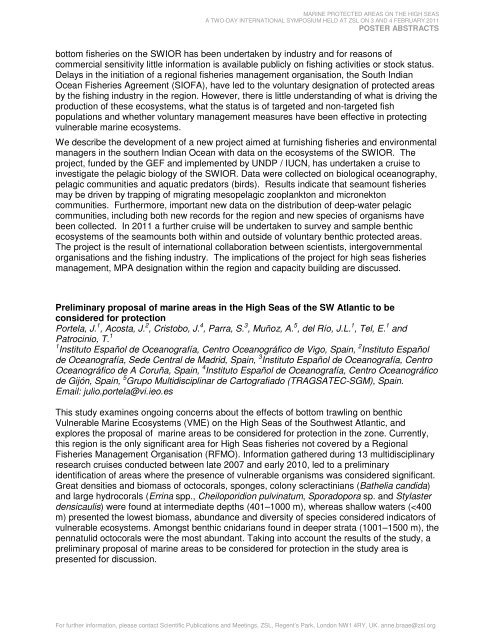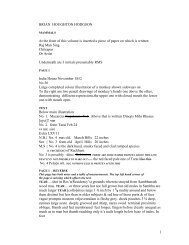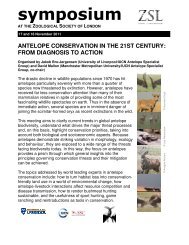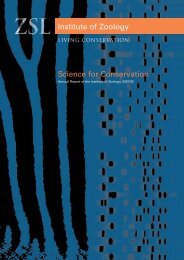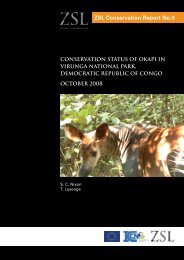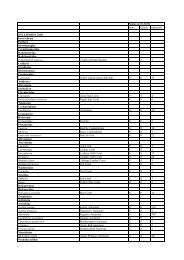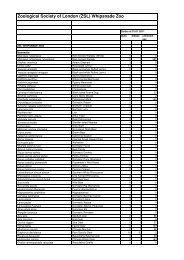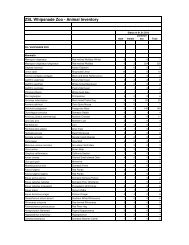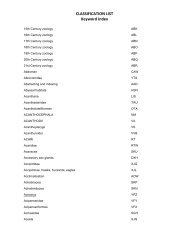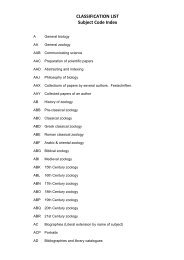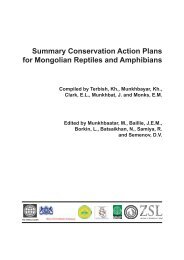MPA Symposium - Zoological Society of London
MPA Symposium - Zoological Society of London
MPA Symposium - Zoological Society of London
Create successful ePaper yourself
Turn your PDF publications into a flip-book with our unique Google optimized e-Paper software.
MARINE PROTECTED AREAS ON THE HIGH SEAS<br />
A TWO-DAY INTERNATIONAL SYMPOSIUM HELD AT ZSL ON 3 AND 4 FEBRUARY 2011<br />
POSTER ABSTRACTS<br />
bottom fisheries on the SWIOR has been undertaken by industry and for reasons <strong>of</strong><br />
commercial sensitivity little information is available publicly on fishing activities or stock status.<br />
Delays in the initiation <strong>of</strong> a regional fisheries management organisation, the South Indian<br />
Ocean Fisheries Agreement (SIOFA), have led to the voluntary designation <strong>of</strong> protected areas<br />
by the fishing industry in the region. However, there is little understanding <strong>of</strong> what is driving the<br />
production <strong>of</strong> these ecosystems, what the status is <strong>of</strong> targeted and non-targeted fish<br />
populations and whether voluntary management measures have been effective in protecting<br />
vulnerable marine ecosystems.<br />
We describe the development <strong>of</strong> a new project aimed at furnishing fisheries and environmental<br />
managers in the southern Indian Ocean with data on the ecosystems <strong>of</strong> the SWIOR. The<br />
project, funded by the GEF and implemented by UNDP / IUCN, has undertaken a cruise to<br />
investigate the pelagic biology <strong>of</strong> the SWIOR. Data were collected on biological oceanography,<br />
pelagic communities and aquatic predators (birds). Results indicate that seamount fisheries<br />
may be driven by trapping <strong>of</strong> migrating mesopelagic zooplankton and micronekton<br />
communities. Furthermore, important new data on the distribution <strong>of</strong> deep-water pelagic<br />
communities, including both new records for the region and new species <strong>of</strong> organisms have<br />
been collected. In 2011 a further cruise will be undertaken to survey and sample benthic<br />
ecosystems <strong>of</strong> the seamounts both within and outside <strong>of</strong> voluntary benthic protected areas.<br />
The project is the result <strong>of</strong> international collaboration between scientists, intergovernmental<br />
organisations and the fishing industry. The implications <strong>of</strong> the project for high seas fisheries<br />
management, <strong>MPA</strong> designation within the region and capacity building are discussed.<br />
Preliminary proposal <strong>of</strong> marine areas in the High Seas <strong>of</strong> the SW Atlantic to be<br />
considered for protection<br />
Portela, J. 1 , Acosta, J. 2 , Cristobo, J. 4 , Parra, S. 3 , Muñoz, A. 5 , del Río, J.L. 1 , Tel, E. 1 and<br />
Patrocinio, T. 1<br />
1 Instituto Español de Oceanografía, Centro Oceanográfico de Vigo, Spain, 2 Instituto Español<br />
de Oceanografía, Sede Central de Madrid, Spain, 3 Instituto Español de Oceanografía, Centro<br />
Oceanográfico de A Coruña, Spain, 4 Instituto Español de Oceanografía, Centro Oceanográfico<br />
de Gijón, Spain, 5 Grupo Multidisciplinar de Cartografiado (TRAGSATEC-SGM), Spain.<br />
Email: julio.portela@vi.ieo.es<br />
This study examines ongoing concerns about the effects <strong>of</strong> bottom trawling on benthic<br />
Vulnerable Marine Ecosystems (VME) on the High Seas <strong>of</strong> the Southwest Atlantic, and<br />
explores the proposal <strong>of</strong> marine areas to be considered for protection in the zone. Currently,<br />
this region is the only significant area for High Seas fisheries not covered by a Regional<br />
Fisheries Management Organisation (RFMO). Information gathered during 13 multidisciplinary<br />
research cruises conducted between late 2007 and early 2010, led to a preliminary<br />
identification <strong>of</strong> areas where the presence <strong>of</strong> vulnerable organisms was considered significant.<br />
Great densities and biomass <strong>of</strong> octocorals, sponges, colony scleractinians (Bathelia candida)<br />
and large hydrocorals (Errina spp., Cheiloporidion pulvinatum, Sporadopora sp. and Stylaster<br />
densicaulis) were found at intermediate depths (401–1000 m), whereas shallow waters (


